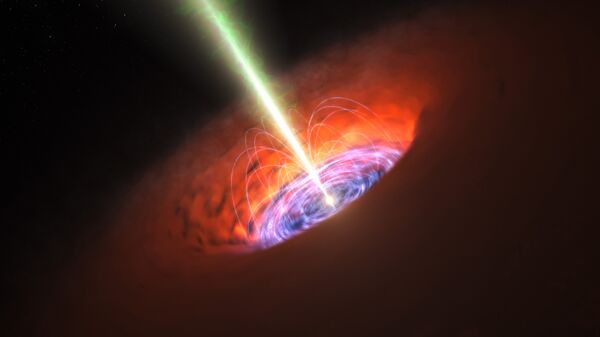In a new paper, Japanese astrophysicists have proposed a search for a whopping 100,000,000 “isolated black holes” that are likely lurking somewhere in the galaxy, and potentially much closer than the one thought to be the nearest to our planet, located less than 3,000 lightyears away from Earth, they wrote in their paper, which has not yet been formally peer reviewed and which came out on 1 July as a preprint on arXiv.
In their paper, the team said these stealthy leviathans emit what they referred to as “synchrotron radiation” during “outflows” produced as they suck up gas – signalling flashes that will make it possible to map more than 700 such “greedy” space areas with an overwhelmingly intense gravitational field in years to come.
According to string theory, black holes have the potential to be shaped like rings, helices, or even like the planet Saturn, but no one actually knows their true shape. pic.twitter.com/PqlD15MJoh
— A Matter Of Fact (@FACTescence) August 3, 2019
These black holes, lost in the darkness, sip matter from the interstellar medium — the dust and other stuff floating between stars. But this process is inefficient, and a great deal of the matter is expelled into space at high speeds.
As the outflow interacts with the surrounding environment, the researchers wrote, it should produce radio waves that human radio telescopes can detect. If astronomers can sift out those waves from all the surrounding noise in the galaxy, they might be able to spot these unseen black holes. To put it in a nutshell, the outflow going through the interstellar medium should get electrons moving at speeds appropriate to produce radio waves.
"A naive way to observe IBHs [intermediate-mass black holes] is through their X-ray emission", the researchers argued.
IBHs, a member on the team, Portegies Zwart, explained, are difficult to detect and are believed to be a "missing link" between the two types of black holes astronomers can now detect: stellar-mass black holes that can be two to 100 times the size of our sun, and supermassive ones that exist at the cores of galaxies and are hundreds of thousands of times the size of our sun.
Meanwhile, the best way to conduct a radio survey of IBHs is thought to employ the Square Kilometre Array (SKA), a multi-part radio telescope due to be built with sections in South Africa and Australia, the research team stated, arguing that it should be enough to accurately estimate the distance to many of these.
Although scientists haven’t yet come up with gloomy predictions that our planet might be sucked into a hole in an act of so-dubbed “spaghettification” (in which the planet would be stretched out into thin, vertically oriented strands), the scenario itself is petrifying. If a black hole skirted our solar system, its gravity would disrupt the course of space rock orbiting a long distance away from the sun, putting them on a new course that could lead them to crash into Earth, as was previously found.

